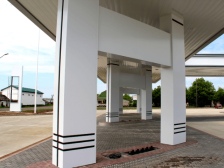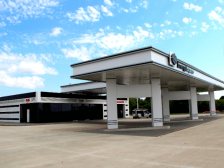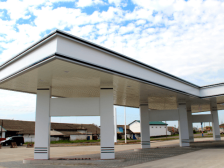Comprehensive Gas Station Equipment from the “Mehbud” Factory
The following Ukrainian building standards (DBNs) are used for the installation of ceilings and facades at gas stations:
- DBN V.2.2-22:2010 “Gas Stations. Basic Requirements for Design and Construction.” This document defines the requirements for the design and construction of gas stations, including requirements for structures, ceilings, and facades.
- DBN V.2.2-11:2006 “Industrial Buildings and Structures.” This document regulates the requirements for the design and construction of industrial buildings, including requirements for structures, ceilings, and facades.
- DBN V.2.2-3-2004 “Warehouses, Shops, Exhibition Halls, and Other Public Buildings.” This document regulates the requirements for the design and construction of public buildings, including requirements for structures, ceilings, and facades.
- DBN V.2.2-4-99 “Construction of Underground Structures.” This document defines the requirements for the design and construction of underground structures, including requirements for structures, ceilings, and facades.
These DBNs specify requirements for materials that can be used for the installation of ceilings and facades, requirements for structures and methods of their installation, as well as safety and operational requirements. Specifically, compliance with fire safety and structural integrity requirements is demanded from structures and materials. Additionally, requirements for the external appearance of facades and ceilings are established to ensure aesthetic appearance and conformity with the architectural style of the building.
Key Principles of Installing Ceilings and Facades According to DBN V.2.2-22:2010 “Gas Stations. Basic Requirements for Design and Construction.”
DBN V.2.2-22:2010 “Gas Stations. Basic Requirements for Design and Construction” contains requirements for the installation of ceilings and facades at gas stations. The fundamental principles of installation include:
- Material Requirements: Materials for ceilings and facades must meet the criteria for strength, operational safety, and aesthetic appearance. Compliance with fire safety requirements is particularly emphasized.
- Construction Installation: Ceilings and facades should be installed in accordance with the project documentation and manufacturer’s requirements. For example, the installation of facade panels should consider wind and snow loads, while ceiling installation should ensure the structural weight and necessary rigidity.
- Safety Requirements: The installation of ceilings and facades must adhere to fire safety and operational safety requirements. For instance, the installation of facade panels should follow fire safety requirements, and ceiling installation should ensure secure fastening and proper ventilation.
- Aesthetic Requirements: Ceilings and facade structures should meet external appearance and aesthetic harmony requirements with the surrounding environment.
- Quality Control: Quality control of ceiling and facade installation should be performed by qualified specialists to ensure the reliability and safety of the structures. Quality control includes verifying compliance with technical material requirements, installation quality, and adherence to design specifications.
- Access to Utilities: During the installation of ceilings and facades, access to utilities (such as electrical, ventilation, and heating systems) should be ensured, allowing convenient operation and maintenance.
- Protection Against Environmental Factors: Ceiling and facade structures should be protected against the influence of aggressive environments, including chemical substances, air pollution, and moisture. Special materials may be used to provide corrosion protection and prevent degradation.
It’s important to note that the external appearance and design of ceilings and facades are crucial aspects in gas station construction. These factors can influence how customers perceive the station and affect their choice. Therefore, adherence to aesthetic requirements and ensuring a harmonious integration of structures with the surrounding environment is essential.
According to DBN V.2.2-22:2010, the design and installation of ceilings and facades at gas stations should consider safety, strength, and aesthetics. Quality control and compliance with requirements should be overseen by qualified specialists.
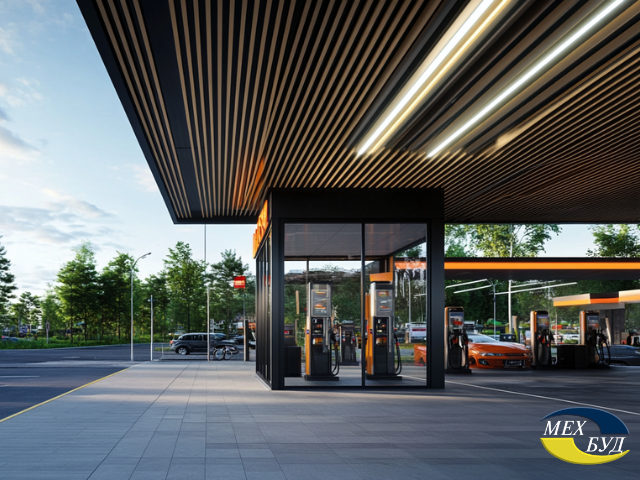
Complexes of gas station buildings (GSB) in the corporate style of the client company are traditionally adorned with metal and metal composite panels.
Many construction companies recognize the “Mehbud” factory as a reliable partner specializing in manufacturing metal facing elements for cladding the facades of gas station building complexes.
Thanks to years of using non-combustible materials for the cladding of auto service buildings, construction companies have become more demanding when it comes to complying with fire safety regulations. They predominantly use painted galvanized steel and aluminum for equipping GSBs.
Trends in Gas Station Design
Modern gas stations are no longer just places to refuel. Today, they have evolved into architectural landmarks, combining functionality with attractive design. A well-thought-out appearance helps businesses stand out in the market and leave a positive impression on customers.
Key trends in gas station design:
- Innovative Facades – The use of rack and cubic-shaped facades gives the structure a modern look while ensuring long-lasting durability.
- Popular Color Schemes – Black and anthracite tones are becoming increasingly popular for their sleek, elegant aesthetic.
- Energy Efficiency and Sustainability – Incorporating materials that reduce energy consumption, along with rainwater harvesting systems, reflects a commitment to environmental care.
- Thoughtful Navigation – Well-designed layouts for rest areas, shops, and cafes improve the customer experience, making the gas station more attractive to visitors.
Mehbud offers comprehensive solutions for gas station design: from modern facades to decorative elements that help create functional and visually appealing spaces, aligned with the latest trends in architecture and design.
The gas station building complex includes:
- Canopy with support columns over the approach area to the fuel dispensers.
- Operator and shop building.
- Information stele.
- Entrance group.
- Signage.
Distinctive elements that set one gas station apart from another include the canopy frieze and information-advertising stele displaying the station’s name and logo. The stele and the illuminated canopy frieze are primary landmarks for drivers and must be visible both during the day and at night. Therefore, special attention is given to their structural design and exterior aesthetics during the planning process.
The cassette and rack cladding of “OKKO” gas stations, manufactured by “Mehbud,” provide ample opportunities for architectural facades and decorative building cladding, allowing for the unique delineation of the building’s structural features through color and the form of facing elements.
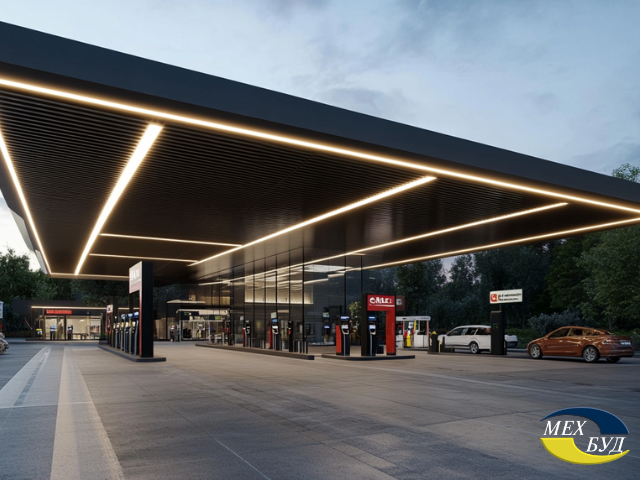
The information stele features a welded metal frame that serves as its supporting structure. It is clad with aluminum or galvanized metal sheets with a specific color from polymer coating and metal thickness ranging from 1 to 4 mm to withstand wind loads. Vertical and horizontal joints of the cassettes, boxes, or rails create stiffening ribs, ensuring structural strength. Cassettes and boxes with bent edges are attached to the frame in a way that conceals the fastening points from the outside.
In addition to its recognition function, the canopy frieze also acts as a parapet around the perimeter of the canopy, providing safety for personnel who service the illuminated part of the frieze. Profiled rack panels and bent metal sheets of considerable length are used in its fabrication, typically fastened with rivets to a supporting profile mounted on brackets.
The flat surface of the metal suspended canopy ceiling over a large area is achieved through the use of long rack panels or cassettes attached to the suspended structure. “Mehbud” factory manufactures standard rack ceiling panels with spans of up to 10 meters and widths ranging from 165 to 400 mm, as well as custom-made panels with widths ranging from 150 to 600 mm.
These panels offer specific advantages:
- Easy installation.
- Sufficient flexibility and strength against deflection.
- Resistance to multiple installations and removals.
- Endurance in various weather conditions.
- Long-lasting coating.
- A wide range of colors and an aesthetically pleasing appearance.
Cassettes, as well as the racks for suspended canopy ceilings, are standard products from the “Mehbud” factory. Due to their small size of 600×600 mm, they are easy to install and technologically advanced. When necessary, they can be easily removed for the installation and maintenance of ceiling lights and video surveillance systems. Both ceiling systems, whether rack or cassette, are versatile, reliable, fire-resistant, come in a wide range of colors, have an excellent appearance, are easy to maintain, and cost-effective.
Cladding of support columns with intercolumn transoms and the decoration of fuel dispensing areas are performed using painted metal sheets with increased thickness ranging from 1 to 4 mm, as they are subject to higher operational loads. Necessary markings, following the corporate style of the ordering company, can be easily applied to the smooth surface of the metal, which is painted with powder enamel.
The advantages of using metal boxes, cassettes, and rack panels for decorative cladding of columns include high strength against deflection due to their significant thickness, sufficient hardness, high indentation resistance, secure fastening, reliable painting, non-flammability, and cost-effectiveness.
The facade of the operator’s building and the store is clad with metal cassettes or profiled racks (metal siding) painted in the required color according to the corporate style of the ordering company.
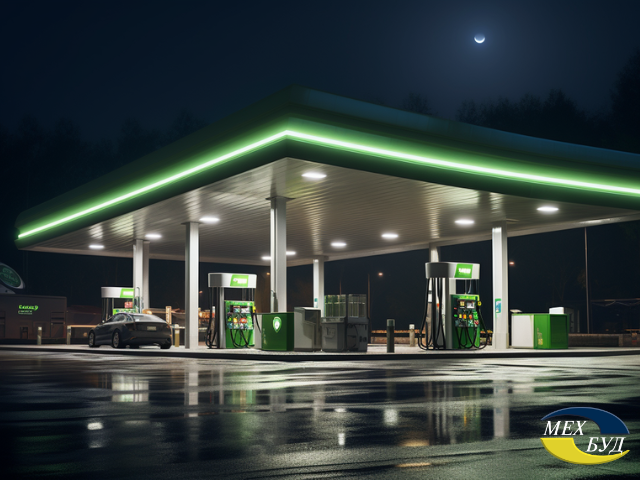
Profiled rack panels from the “Mehbud” factory are among the most reliable on the construction market, thanks to the “lock” connection design developed by the company. As a result, the suspended facade appears as a unified and cohesive element with high strength against both transverse stretching and bending of the rails. This design feature adds a robust stiffening rib, increasing the facade cladding’s strength against bending and ensuring secure fastening. These two factors were decisive in selecting a supplier of cladding elements for one of the projects of the OKKO gas station complex.
Furthermore, the production facility has provided products for comprehensive cladding of gas stations for “Lukoil,” LUXWEN, “Avias,” “Ukrnafta,” TNK, and BRS.
No matter the gas station construction project, the “Mehbud” factory is ready to supply a complete set of necessary cladding metal elements for building facades, ensuring full compliance with building standards and customer requirements.

